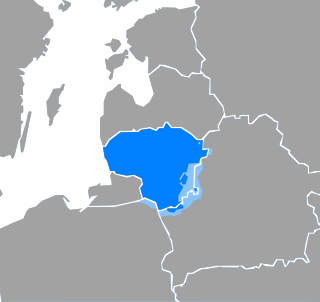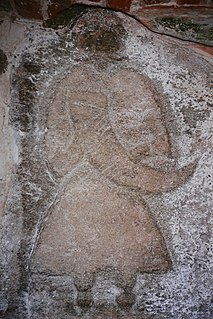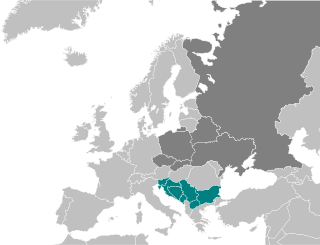
The Cyrillic script is a writing system used for various languages across Eurasia and is used as the national script in various Slavic, Turkic, Mongolic and Iranic-speaking countries in Southeastern Europe, Eastern Europe, the Caucasus, Central Asia, North Asia and East Asia.

The East Slavic languages constitute one of the three regional subgroups of Slavic languages, currently spoken throughout Eastern Europe, Northern Asia, and the Caucasus. It is the group with the largest numbers of speakers, far out-numbering the Western and Southern Slavic groups. The existing East Slavic languages are Belarusian, Russian and Ukrainian; Rusyn is considered to be either a separate language or a dialect of Ukrainian.

Pan-Slavism, a movement which crystallized in the mid-19th century, is the political ideology concerned with the advancement of integrity and unity for the Slavic peoples. Its main impact occurred in the Balkans, where non-Slavic empires had ruled the South Slavs for centuries. These were mainly the Byzantine Empire, Austria-Hungary, the Ottoman Empire, and Venice.

The Slavic languages, also known as the Slavonic languages, are Indo-European languages spoken primarily by the Slavic peoples or their descendants. They are thought to descend from a proto-language called Proto-Slavic, spoken during the Early Middle Ages, which in turn is thought to have descended from the earlier Proto-Balto-Slavic language, linking the Slavic languages to the Baltic languages in a Balto-Slavic group within the Indo-European family.
Slavic, Slav or Slavonic may refer to:

Slavs are a European ethno-linguistic group of people who speak the various Slavic languages of the larger Balto-Slavic linguistic group of the Indo-European languages. They are native to Eurasia, stretching from Central, Southeastern and Eastern Europe, all the way north and eastwards to Northeast Europe, Northern Asia (Siberia) and Central Asia, as well as historically in Western Europe and Western Asia. From the early 6th century they spread to inhabit most of Central, Eastern and Southeastern Europe. Today, there is a large Slavic diaspora throughout the Americas, particularly in the United States, Canada and Brazil as a result of immigration.

Old Church Slavonic or Old Slavonic was the first Slavic literary language.

The East Slavs are Slavic peoples speaking the East Slavic languages. Formerly the main population of the loose medieval Kievan Rus federation state, by the seventeenth century they evolved into the Belarusian, Russian, Rusyn and Ukrainian people.

Ukrainian, historically also Ruthenian is an East Slavic language. It is the native language of the Ukrainians the official state language of Ukraine and one of the three official languages in the unrecognized state of Transnistria, the other two being Moldovan and Russian. Written Ukrainian uses a variant of the Cyrillic script.

Lithuanian is a Baltic language. It is the official language of Lithuania and one of the official languages of the European Union. There are about 2.8 million native Lithuanian speakers in Lithuania and about 200,000 speakers elsewhere.
Slavic studies, Slavonic studies or Slavistics is the academic field of area studies concerned with Slavic areas, Slavic languages, literature, history, and culture. Originally, a Slavist or Slavicist was primarily a linguist or philologist researching Slavistics, a Slavic (AmE) or Slavonic (BrE) scholar. Increasingly historians and other humanists and social scientists who study Slavic area cultures and societies have been included in this rubric.

Slavic paganism or Slavic religion describes the religious beliefs, myths and ritual practices of the Slavs before Christianisation, which occurred at various stages between the 8th and the 13th century. The South Slavs, who likely settled in the Balkan Peninsula during the 6th–7th centuries AD, bordering with the Byzantine Empire to the south, came under the sphere of influence of Eastern Orthodox Christianity, beginning with the creation of writing systems for Slavic languages in 855 by the brothers Saints Cyril and Methodius and the adoption of Christianity in Bulgaria in 863. The East Slavs followed with the official adoption in 988 by Volodymyr the Great of Kievan Rus'.

Old East Slavic was a language used during the 10th–15th centuries by East Slavs in Kievan Rus' and its successor states, from which the Belarusian, Russian, Rusyn, and Ukrainian languages later evolved.

The South Slavic languages are one of three branches of the Slavic languages. There are approximately 30 million speakers, mainly in the Balkans. These are separated geographically from speakers of the other two Slavic branches by a belt of German, Hungarian and Romanian speakers. The first South Slavic language to be written was the variety spoken in Thessaloniki, now called Old Church Slavonic, in the ninth century. It is retained as a liturgical language in some South Slavic Orthodox churches in the form of various local Church Slavonic traditions.

The Balto-Slavic languages are a branch of the Indo-European family of languages. It traditionally comprises the Baltic and Slavic languages. Baltic and Slavic languages share several linguistic traits not found in any other Indo-European branch, which points to a period of common development. Although the notion of a Balto-Slavic unity has been contested, there is now a general consensus among specialists in Indo-European linguistics to classify Baltic and Slavic languages into a single branch, with only some details of the nature of their relationship remaining in dispute.

Proto-Balto-Slavic (PBS) is a reconstructed proto-language descending from Proto-Indo-European (PIE). From Proto-Balto-Slavic, the later Balto-Slavic languages are thought to have developed, composed of sub-branches Baltic and Slavic, and including modern Lithuanian, Polish, Russian and Serbo-Croatian among others.

The South Slavs are a subgroup of Slavic peoples who speak the South Slavic languages. They inhabit a contiguous region in the Balkan Peninsula and the eastern Alps, and in the modern era are geographically separated from the body of West Slavic and East Slavic people by the Romanians, Hungarians, and Austrians in between. The South Slavs today include the nations of Bosniaks, Bulgarians, Croats, Macedonians, Montenegrins, Serbs and Slovenes. They are the main population of the Eastern and Southeastern European countries of Bosnia and Herzegovina, Bulgaria, Croatia, Montenegro, North Macedonia, Serbia and Slovenia.

Deities of Slavic religion, arranged in cosmological and functional groups, are inherited through mythology and folklore. Both in the earliest Slavic religion and in modern Slavic Native Faith's theology and cosmology, gods are arranged as a hierarchy of powers begotten by the supreme God of the universe, Rod, known as Deivos in the earliest Slavic religion. According to Helmold's Chronica Slavorum, "obeying the duties assigned to them, [the deities] have sprung from his [the supreme God's] blood and enjoy distinction in proportion to their nearness to the god of the gods".

The early Slavs were a diverse group of tribal societies who lived during the Migration Period and the Early Middle Ages in Central and Eastern Europe and established the foundations for the Slavic nations through the Slavic states of the High Middle Ages. The first written use of the name "Slavs" dates to the 6th century, when the Slavic tribes inhabited a large portion of Central and Eastern Europe. By then, the nomadic Iranian ethnic groups living on the Eurasian Steppe had been absorbed by the region's Slavic population. Over the next two centuries, the Slavs expanded southwest toward the Balkans and the Alps and northeast towards the Volga River. The Slavs' original habitation is still a matter of controversy, but scholars believe that it was somewhere in Eastern Europe.

Proto-Slavic is the unattested, reconstructed proto-language of all the Slavic languages. It represents Slavic speech approximately from the 2nd millennium B.C. through the 6th century A.D. As with most other proto-languages, no attested writings have been found; scholars have reconstructed the language by applying the comparative method to all the attested Slavic languages and by taking into account other Indo-European languages.













